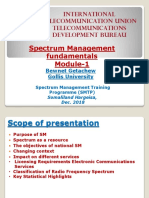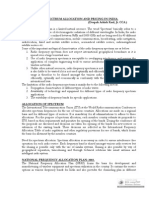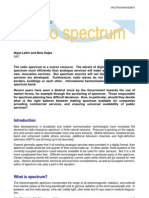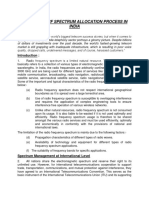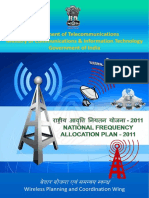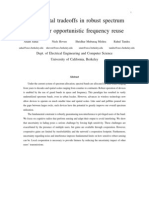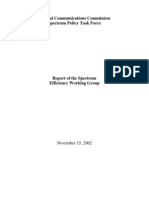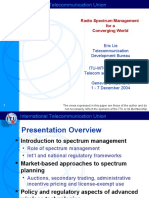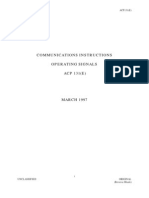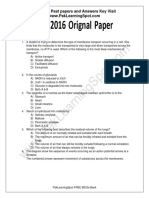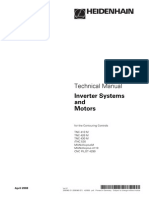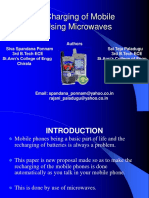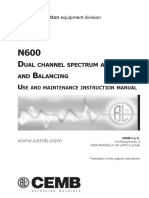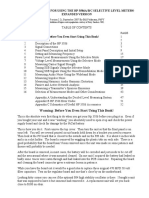Introduction to Spectrum Management
The regulation of radio frequencies to promote efficiency and social benefit is known as
spectrum management. This entails the efficient utilization, planning, coordination, and
administration of electromagnetic frequency ranges in order to inhibit disruptions while
facilitating optimal usage for various services and users.
Importance:
1. The proper utilization of a scarce resource is vital for obtaining maximum advantages,
and the radio spectrum falls under this category. Its efficient administration plays an
integral role in achieving optimal outcomes.
2. Prevention of Interference: Effective management of the spectrum decreases the
likelihood of detrimental interference among various users, guaranteeing dependable
communication.
3. Spectrum management has the potential to boost a nation's economy by generating
substantial revenue through licensing and auctions.
4. Facilitation of Innovation: Appropriate management techniques for the spectrum promote
technological advancement by establishing precise regulations and instructions to manage
distinct frequency ranges.
5. The public services and safety sector guarantees that there is access to spectrum for
critical activities such as emergency response, national defense, and public safety.
1
� Key Objectives of Spectrum Management
1. Maximize Efficient Utilization: Guarantee that the spectrum is utilized in an optimal way,
preventing both underutilization and overuse.
2. To avert detrimental disruption: Take steps to prevent interference that could impair
communication technologies and services.
3. Facilitate Innovation and Competition: Foster a regulatory milieu that promotes the
advancement of innovation and competition in the telecommunications sector.
4. Satisfy both the public and national needs by assigning frequency bands to essential
public services, such as emergency response systems, safeguarding of citizens' well-
being, and military operations.
5. To generate revenue for the government, consider utilizing spectrum licensing and
auctions.
6. Collaborate with international organizations such as the ITU to promote synchronization
of spectrum utilization globally, guaranteeing worldwide interoperability while
minimizing cross-border disruption.
7. To foster the growth and success of new and evolving technologies, it is crucial to tailor
spectrum policies in a manner that accommodates them appropriately. This involves
facilitating access to adequate spectrum resources for their development while also
offering continued support as they expand further.
2
� Radio Frequency Spectrum
Basic Concepts of Radio Frequency (RF) Spectrum
Covering a range of frequencies from 3 Hz to 300 GHz, the radio frequency spectrum is an
integral part of the electromagnetic spectrum. This entails all wireless communication that
employs various frequencies.
Frequency and Wavelength:
Hertz (Hz) is the unit of measurement for frequency, which indicates how many cycles per
second a radio wave completes. The distance covered by a radio wave in one cycle defines its
wavelength and is inversely correlated with its frequency.
Propagation Characteristics:
i. Low Frequencies (3 Hz - 30 kHz): Long wavelengths, can travel long distances, penetrate
water and soil.
ii. Medium Frequencies (30 kHz - 3 MHz): Used for AM radio, longer range but subject to
interference.
iii. High Frequencies (3 MHz - 30 MHz): Used for shortwave radio, can travel long distances
by reflecting off the ionosphere.
iv. Very High Frequencies (30 MHz - 300 MHz): Used for FM radio, TV broadcasting; line-
of-sight propagation.
v. Ultra High Frequencies (300 MHz - 3 GHz): Used for TV broadcasting, mobile phones,
GPS; line-of-sight, limited range.
3
�vi. Super High Frequencies (3 GHz - 30 GHz): Used for satellite communication, radar; line-
of-sight, limited to very high bandwidth applications.
vii. Extremely High Frequencies (30 GHz - 300 GHz): Used for advanced communication
systems; high data rates, short range.
Spectrum Bands and their Uses
i. Low Frequency (LF) Band (30 kHz - 300 kHz): Maritime communication, navigational
aids, time signals.
ii. Medium Frequency (MF) Band (300 kHz - 3 MHz): AM radio broadcasting, maritime
and aviation communication.
iii. High Frequency (HF) Band (3 MHz - 30 MHz): Shortwave radio broadcasting,
amateur radio, military communication.
iv. Very High Frequency (VHF) Band (30 MHz - 300 MHz): FM radio broadcasting, TV
channels 2-13, air traffic control, marine communication.
v. Ultra High Frequency (UHF) Band (300 MHz - 3 GHz): TV channels 14-69, mobile
phones, GPS, Wi-Fi, Bluetooth, two-way radios.
vi. Super High Frequency (SHF) Band (3 GHz - 30 GHz): Satellite communication,
microwave links, radar systems, 5G networks.
vii. Extremely High Frequency (EHF) Band (30 GHz - 300 GHz): Advanced
communication systems, high-frequency radar, experimental applications.
4
� Spectrum Allocation and Assignment
The allocation of spectrum involves assigning frequency bands to particular services or purposes.
Normally, this task is carried out by regulatory agencies at the national level and by the ITU on
an international scale.
Objective: To guarantee the smooth operation of distinct services with no disruption between
them. Illustration: The reservation of 700 MHz frequency range for mobile broadband utilization.
The act of assigning particular frequency bands to individual users or organizations is referred to
as the Spectrum Assignment. Such an assignment can be carried out either through licensing
processes, regulatory mechanisms, or other means.
Methods of Assignment:
i. Administrative Assignment: Frequencies are assigned through applications directly to the
regulatory body for administrative assignment.
ii. Market-Based Assignment: The allocation of frequencies is determined by auctions or
competitive bidding processes in the market-based assignment.
iii. Unlicensed Use: Frequency bands are set aside for unlicensed usage, allowing devices to
operate without obtaining individual licenses and typically with specific technical limitations
(such as Wi-Fi in the 2.4 GHz and 5 GHz bands). For instance, spectrum auctions may occur
for mobile services implementing 4G or 5G technology.
Regulatory Bodies:
International Telecommunication Union (ITU): In charge of worldwide coordination for the
allocation of spectrum and establishment of international regulations.
5
�National Regulatory Authorities: The spectrum allocation and assignment within a country's
territory are managed by its own regulatory body such as the FCC in the USA or Ofcom in the
UK.
Considerations in Allocation and Assignment:
1. Technical Efficiency: Technical efficiency refers to the utilization of the spectrum in a
manner that maximizes its performance.
2. Economic Efficiency: Efficient utilization of spectrum for deriving maximum economic
benefits.
3. Public Interest: The aim of Public Interest is to guarantee that the use of spectrum
benefits society, incorporating measures for public safety, national security as well as
other vital services.
4. Flexibility: Flexibility involves accommodating changes and reallocating resources as
technology advancements and demand shift over time.
Regulatory Framework
International Telecommunication Union (ITU)
The ITU, a United Nations specialized agency, has been tasked with handling matters concerning
information and communication technologies (ICTs). Its responsibilities include managing the
radio-frequency spectrum as well as satellite orbits on a global scale.
Structure
ITU-R (Radio communication Sector): Focuses on radio communication and spectrum
management.
6
�ITU-T (Telecommunication Standardization Sector): Develops international standards (ITU-
T Recommendations).
ITU-D (Telecommunication Development Sector): Aims to foster international cooperation
and assist in the development of ICTs.
Functions:
Global Coordination: Coordinates global spectrum allocation to prevent interference between
countries and ensure efficient spectrum use.
Radio Regulations: Develops and maintains the Radio Regulations, an international treaty
governing the use of the RF spectrum and satellite orbits.
World Radio communication Conferences (WRC): Held every 3-4 years to review and revise
the Radio Regulations based on emerging technologies and needs.
Impact on Spectrum Management:
Harmonization: Facilitates international harmonization of spectrum use, enabling global
compatibility and interoperability of communication systems.
Guidance and Standards: Provides guidelines and standards that national regulatory authorities
adopt and implement within their jurisdictions.
7
� National Regulatory Authorities
Role and Responsibilities:
It is the responsibility of national regulatory authorities to oversee spectrum management in their
respective countries. Their tasks involve allotting spectrums, issuing licenses, enforcing and
ensuring conformity with global regulations. Examples of National Regulatory Authorities:
Federal Communications Commission (FCC) – USA: The responsibilities involve overseeing
the distribution and authorization of frequencies, implementing measures to mitigate signal
disruption, and organizing auctions for spectrum licenses.
Ofcom – UK: The authority ensures effective utilization of the spectrum, supervises licensing
and compliance, and actively participates in formulating policies to promote the growth of
cutting-edge technologies.
Australian Communications and Media Authority (ACMA) – Australia: The duties include
distributing and designating frequencies for diverse purposes, regulating licensing regulations
and adherence, crafting policies concerning spectrum management.
Functions:
Spectrum Allocation: Spectrum allocation is the process of assigning specific portions of the
spectrum for different services such as broadcasting, mobile and satellite communications.
Licensing: Grants licenses to both organizations and individuals permitting the utilization of
designated frequency ranges.
8
�Monitoring and Enforcement: To ensure adherence to regulations and address interference
problems, monitoring and enforcement of spectrum use are conducted.
Policy Development: The development of policies is focused on adapting to technological
advancements and changing market demands at the national level.
Nigerian Communications Commission (NCC)
In Nigeria, the Nigerian Communications Commission (NCC) serves as the regulatory body for
telecommunications. It holds various crucial roles and obligations aimed at efficiently overseeing
and regulating this industry in the country.
Key Functions of the NCC:
1. Regulatory Oversight
Licensing: The act of issuing licenses to telecom operators and service providers.
Regulation Enforcement: Enforcing Regulations: Guaranteeing adherence to
telecommunications legislation, rules, and standards
2. Spectrum Management
Spectrum Allocation: Assigning radio frequency spectrum to different telecommunications
users and services.
Monitoring and Enforcement: The act of supervising spectrum usage and implementing
regulations to deter and address problems regarding interference.
9
� 3. Policy Development and Implementation
Telecommunications Policies: The objective is to design and execute telecommunications
policies with the aim of fostering expansion and progress within the sector.
Harmonization: Harmonization aims to synchronize domestic policies with global benchmarks
and optimal methodologies.
4. Promoting Competition
Market Liberalization: The objective of market liberalization is to foster equitable competition
in the telecom industry, thereby providing a level ground for all operators.
Anti-Competitive Practices: Preventing and Addressing Anti-Competitive Behaviors Among
Service Providers: The Fight against Monopolistic Practices.
5. Protection of Consumers
The aim is to guarantee the provision of superior telecommunications services that meet
consumer expectations, known as Quality of Service. The protection of consumer rights and
interests, which encompasses the resolution of grievances and conflicts.
6. Innovation and Technical Standards
The process of establishing and implementing technical specifications for telecommunication
equipment and services is referred to as standardization.
The promotion and facilitation of novel ideas and the integration of cutting-edge technologies in
the telecommunications industry is referred to as Innovation Support.
7. Provision of universal service: Encouraging equal access to telecommunication services,
particularly in underprivileged and rural regions. To extend coverage to remote areas, service
10
�providers can be encouraged through the provision of subsidies and incentives.
8. Regulation of the economy: One possible rewrite of this sentence could be: Tariff regulation
involves setting and overseeing tariffs and pricing structures in order to promote both
accessibility and equity.
9 Promoting Investment: Encouraging investments in the telecommunications industry while
cultivating an advantageous investment atmosphere.
10 Cooperation between countries on a global level; Working with international bodies like
ITU to embrace worldwide telecommunications standards.
11 Collaborative Efforts Across Borders: Working together with adjacent nations to handle
cross-border frequency disruption and other governmental concerns.
12 National security and public safety: Emergency Services: Guaranteeing the accessibility of
telecommunications services for emergency and public safety purposes. Protecting
telecommunications infrastructure and data from security threats through implementation of
necessary measures.
13 Targeted Actions and Schemes: Through diverse initiatives and programs, Digital Nigeria is
championing the promotion of digital literacy and inclusion. The initiative of Broadband
Expansion aims at executing tactics to promote the proliferation and accessibility of
broadband technology throughout the nation. Assisting the growth of Nigeria's Information
and Communication Technology (ICT) industry through ICT Development.
14 Development of policies and licensing procedures related to the use of spectrum.
Licensing of Spectrum:
11
�There are different types of licenses available.
1. Specific licenses are assigned to either a particular user or organization, commonly through
auctions or direct assignment.
2. Class licenses enable the utilization of particular spectrum bands under predetermined terms
(such as Wi-Fi) without requiring individual licensure.
3. Bands have been designated for unlicensed use, which means these can be utilized without the
need for any licensing requirements. These bands are typically reserved for low-power devices.
There are two different licensing processes available.
Assignment in Administration: Selection based on submitted applications and regulatory
standards.
Efficient spectrum allocation can be achieved through market-based approaches such as auctions
and competitive bidding processes.
Development of Policy:
The objectives and goals include promoting fair use of the spectrum while ensuring efficiency, in
addition to encouraging innovation and competition. Furthermore, it aims to protect national
security interests as well as public welfare.
Areas of Policy that are Essential:
1. Refarming the Spectrum: The process of reallocating spectrum from less efficient applications
to more effective or higher-value services.
2. Policies are being implemented to facilitate the utilization of spectrum in a flexible manner,
through means such as cognitive radio technologies - this is known as Dynamic Spectrum
Access.
12
�3. Creating spectrum sharing frameworks that facilitate the shared use of available frequencies
among various users and services.
4. Harmonization refers to the process of adjusting domestic policies in line with international
standards and practices, so as to promote universal interoperability.
Means of implementation for policies.
1. Regulations refer to the official regulations and guidelines that mandate how spectrum usage
is managed.
2. Economic incentives, such as spectrum fees and subsidies for technological upgrades are
utilized to encourage efficient use of spectrum.
3. Engaging stakeholders (including industry, academia, and the public) in policy-making
processes through consultations and feedback mechanisms is a crucial component.
13



